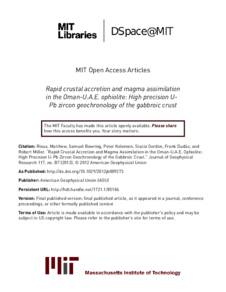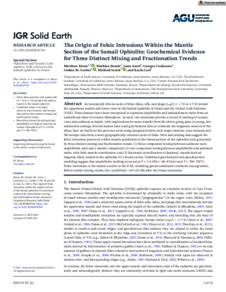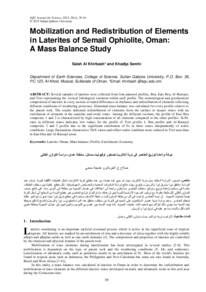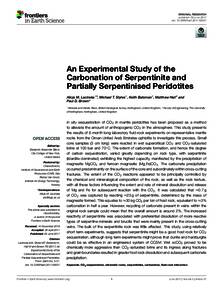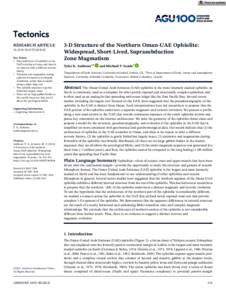وثيقة
Rapid crustal accretion and magma assimilation in the Oman-U.A.E. ophiolite : high precision u-Pb zircon geochronology of the gabbroic crust.
المعرف
DOI: 10.1029/2012JB009273
المساهمون
Bowring, Samuel., مؤلف
Kelemen, Peter., مؤلف
Gordon, Stacia., مؤلف
Dudás, Frank., مؤلف
Miller, Robert., مؤلف
الناشر
American Geophysical Union.
ميلادي
2012-07
اللغة
الأنجليزية
الموضوع
الملخص الإنجليزي
New high-precision U/Pb zircon geochronology from the Oman-United Arab Emirates (U.A.E.) ophiolite provides insight into the timing and duration of magmatism and the tectonic setting during formation of the lower crust. The new data come from a well-preserved and exposed crustal section in the center of the Wadi Tayin massif. Single grain and grain fragment 206Pb/ 238U dates from upper-level gabbros, tonalites/trondhjemites and gabbroic pegmatites, corrected for initial Th exclusion, range from 112.55 0.21 to 95.50 0.17Ma, with most data clustered between 96.40 0.17 to 95.50 0.17Ma. Zircon dates from upper-level gabbros are most consistent with the ophiolite forming at a fast spreading ridge with half-rates of 50-100km/Ma. Dates from tonalites/trondhjemites and from a gabbroic pegmatite associated with a wehrlite intrusion overlap with dates from adjacent upper-level gabbros, suggesting that any age differences between these three magmatic series are smaller than the analytical uncertainties or intrasample variability in the dates. Three of the dated upper-level gabbros and a single gabbroic pegmatite from the base of the crust have >1Ma intrasample variability in single grain dates, suggesting assimilation of older crust during the formation or crystallization of the magmas. Whole rock Nd(t) of seven samples, including the upper-level gabbros with variable zircon dates, have tightly clustered initial values ranging from Nd(96Ma) = 7.59 0.23 to 8.28 0.31. The Nd values are similar to those from other gabbros within the ophiolite, suggesting that any assimilated material had a similar isotopic composition to primitive basaltic magmas. The new dates suggest that the studied section formed at a fast spreading mid-ocean ridge between ∼96.4-95.5Ma. The large intrasample variability in zircon dates in some samples is unexpected in this setting, and may be related to propagation of a younger ridge into older oceanic lithosphere.
المجموعة
ISSN
2169-9313
URL المصدر
قالب العنصر
مقالات الدوريات

